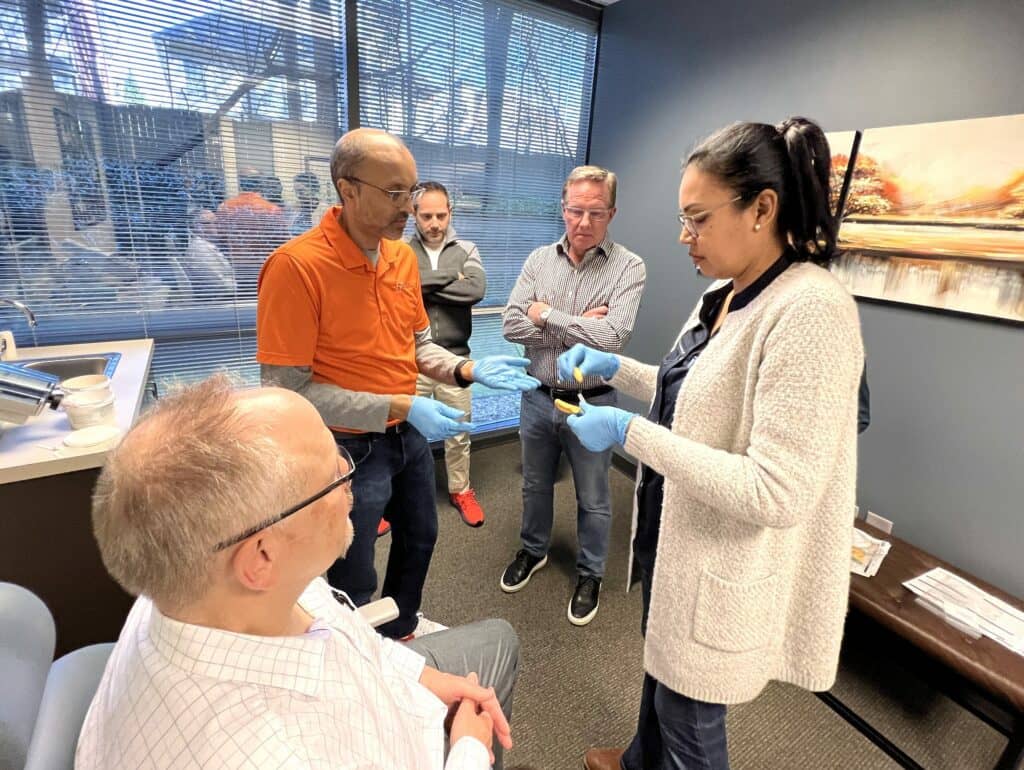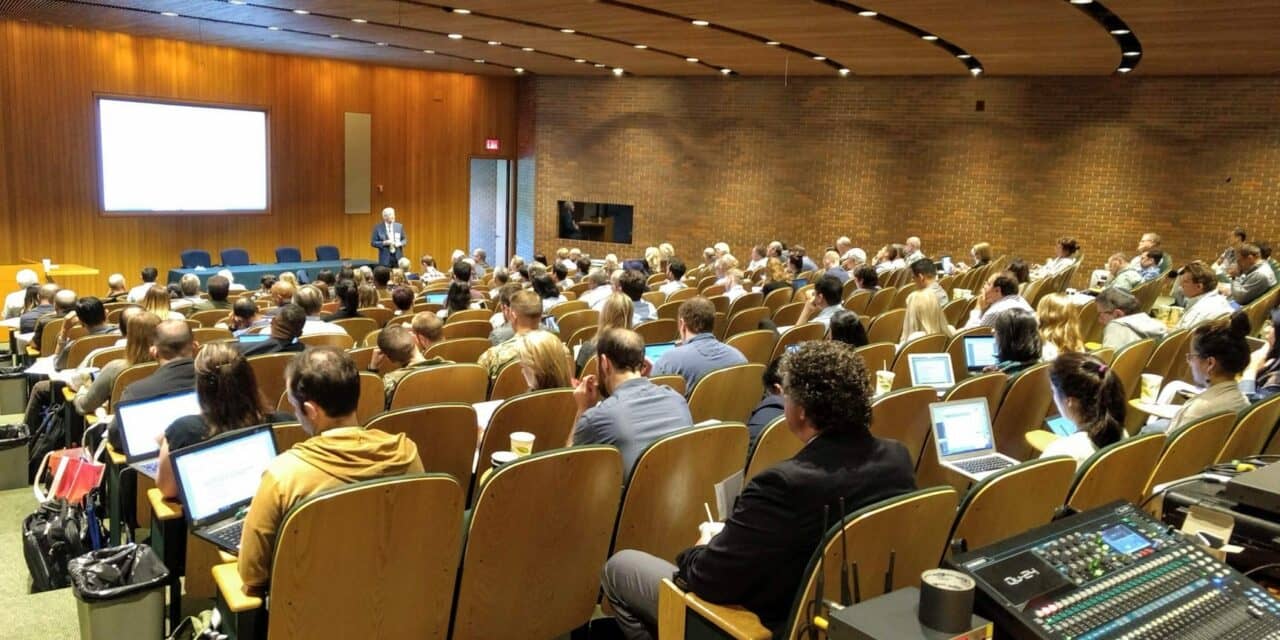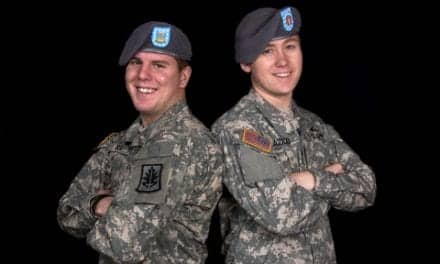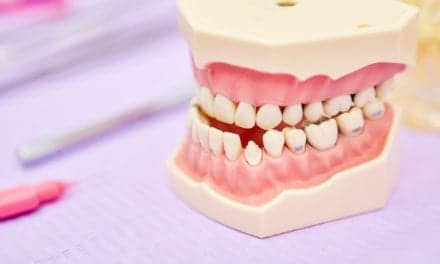These intensive programs let dentists gain practical skills to expand into dental sleep medicine while continuing to work full-time at their existing practice.
By Alyx Arnett
As awareness of the impact of sleep disorders on overall health continues to grow, so too does the demand for professionals trained in the field of dental sleep medicine (DSM). For dentists looking to expand their skill sets, dental sleep medicine mini-residency programs offer practical, condensed training.
Here’s a closer look at some of the available DSM mini-residency programs, typically offered once or twice a year, highlighting key features and benefits for aspiring practitioners.
AADSM Mastery Program
The American Academy of Dental Sleep Medicine (AADSM) Mastery Program is a clinically focused program based on the AADSM’s standards for the screening, treatment, and management of sleep-related breathing disorders in adults using oral appliance therapy.
“Our program is evidence-based and unbiased. Rather than learning about a specific appliance or technique, our attendees learn foundational knowledge and skills that support their clinical judgment and decision-making, allowing them to provide personalized care for each patient,” says Coreen Vick, AADSM director of clinical services.
Details: The program consists of Mastery 1 (virtual) and Mastery 2 (virtual with an in-person component), which are offered separately.
Mastery 1 is designed for dentists with little or no background in treating OSA and snoring with oral appliance therapy. The course examines fundamental concepts and practical techniques necessary to incorporate oral appliance therapy into a general or specialty dental practice.
Mastery 2 lectures develop a more in-depth understanding of DSM, including administrative strategies for practice growth. An in-person, two-day workshop prepares students to submit two oral appliance therapy cases on real patients.
Learning objectives include:
- Establish a screening protocol and physician referral network
- Treat OSA with confidence by identifying patients at risk for sleep-disordered breathing, performing a sleep interview and DSM examination, discussing informed consent, determining a protrusive bite position, acquiring impressions, and designing and fitting a mandibular advancement device
- Communicate device design to laboratories, avoid costly mistakes, and consider benefits of digital technology in practice
- Perfect an algorithm for patient management that begins with screening and ends with long-term follow-up
Outcomes: Dentists will have the competence and confidence to provide oral appliance therapy and build relationships with patients, physicians, and payers, according to AADSM’s program website.
Program lead: Patricia Braga, DDS, AADSM director of education, entered the field of DSM in 2006. She began limiting her practice to DSM in 2014 and completed the transition in less than a year.
Cost: $3,400 for Mastery 1, $5,400 for Mastery 2, or $7,800 for both when purchased together (non-member) or $3,000 for Mastery 1, $4,500 for Mastery 2, or $6,500 for both when purchased together (member)
Continuing education credits: >100
Location: University of Illinois at Chicago College of Dentistry, Chicago, Illinois
More information: www.aadsm.org/aadsm_mastery_program.php
Tufts University Dental Sleep Medicine Mini-Residency
Offering a blend of live-streamed online lectures and in-person workshops, the Tufts University’s DSM mini-residency program emphasizes the interconnection between sleep medicine, DSM, and temporomandibular disorders (TMD).
Details: The six-month program is divided into three three-day modules (two offered virtually), with two one-day virtual intermodules between sessions. On-site curriculum includes lectures by clinicians and researchers, hands-on sessions, and clinical case-based learning. Guided self-study includes literature review and assignments, intermodule webinars, and practice quizzes.
The program has been designated as an accredited AADSM Mastery Program Provider. Attendees of accredited Mastery Program Provider programs are eligible to earn the AADSM Qualified Dentist designation and apply for the American Board of Dental Sleep Medicine certification exam through the Mastery Track.
Learning objectives include:
- Develop a deeper understanding of sleep, the physiology of sleep, chronobiology, breathing- and non-breathing-related sleep disorders, sleep-related movement disorders, upper airway resistance syndrome, adult and pediatric OSA, and the health consequences of sleep deficiency
- Understand the interrelationship between TMD and sleep
- Develop proper examination principles and bite registration techniques
- Learn how to get started screening, evaluating, referring, and managing OSA patients
- Obtain an unbiased review of oral appliances for the management of OSA and review appliance selection criteria
- Practice bite registration techniques for OSA oral appliance therapy
- Gain experience using several custom-fabricated oral appliances with hands-on appliance fitting and adjustment workshops
Outcomes: Participants will have the knowledge to incorporate DSM into their practice, including working with sleep laboratories and medical-legal issues related to DSM practice, according to the program’s website.
Program coordinators: Noshir R. Mehta, BDS, DMD, MDS, MS, is a senior adviser to the Craniofacial Pain, Headache, and Sleep Center at Tufts University School of Dental Medicine
Leopoldo P. Correa, BDS, MS, is the director of the division of Craniofacial Pain in the department of Diagnostic Sciences at Tufts University School of Dental Medicine and program director of the division’s two advanced graduate education programs: the Dental Sleep Medicine Fellowship and the Orofacial Pain Advanced Graduate Education program.
Jonathan Parker, DDS, is an adjunct clinical professor at Tufts University School of Dental Medicine. Since 2001, he has focused his practice full-time on DSM.
Cost: $12,000
Continuing education credits: ~120
Location: Tufts University School of Dental Medicine, Boston, Massachusetts
More information: https://reg.learningstream.com/reg/event_page.aspx?ek=0057-0020-82e55087f9494d13a0efae942df3a31e, [email protected], 617-636-6629

Hands-on and Didactic Maxi-Residency in Craniofacial Pain and Dental Sleep Medicine
This program merges the topics of craniofacial pain and DSM, encouraging dentists and their teams to screen for both in their practices. The program includes workshops for hands-on experience with dental sleep appliances and evaluation techniques. The curriculums for craniofacial pain and DSM, previously taught separately, were bridged two and a half years ago due to so much crossover between subjects.
“We always preach that you cannot treat one without knowing the other,” says Mayoor Patel, DDS, MS, program instructor.
Details: The course, which will start being offered at Tufts University School of Dental Medicine this October, is made up of four two-day sessions spanning four months. Two sessions can be taken in person or live-streamed virtually. The program covers topics such as anatomy related to sleep and TMD, pharmacology for pain, and oral appliance therapy for sleep. Attendees receive two dental sleep appliances made for themselves.
Learning objectives include:
- Basic understanding of the physiology of sleep, breathing, sleep-related movement disorders, upper airway resistance syndrome, and adult and pediatric OSA
- Review of health consequences of sleep deficiency
- Understand the anatomy as it relates to the upper airway
- Understand the interrelationship between TMD and sleep
- Review the common orofacial pain disorders (internal derangements, muscle disorders, neuropathic, neurovascular) and their diagnostic criteria
- Review patient intake forms and conduct a comprehensive interview to gather clues to help with a differential diagnosis
- Review of oral appliances for the management of OSA and which appliance is appropriate for each case
- Hands-on appliance fitting, adjustment, and troubleshooting
- Indication and contraindications of injections for orofacial pain, plus hands-on module
- Fabricating temporary appliances for TMD and sleep
Outcomes: Attendees can begin screening their patients for underlying issues involving pain and sleep-related breathing disorders and make the referrals to get them diagnosed, according to the program’s website.
Program instructors: Mayoor Patel, DDS, MS, is the co-founder of the British Academy of Dental Sleep Medicine and Ben-Pat Institute. Since 2003, he has limited his practice to the treatment of TMJ, headaches, orofacial pain, and sleep apnea.
Terry R. Bennett, DMD, is the co-founder of Ben-Pat Institute and owner of Tulsa TMJ & Orofacial Pain Center. For over three decades, he has limited his practice to the conservative treatment of TMD and sleep apnea.
Cost: $9,975
Continuing education credits: 60
Location: Tufts University School of Dental Medicine, Boston
More information: https://dental.tufts.edu/continuing-education/tufts-dental-mini-maxi-residency-programs, [email protected], 617-636-6629

Nierman Dental Sleep Medicine Mini-Residency
Nierman Practice Management’s DSM mini-residency is an educational program for implementing airway and sleep apnea treatment into a dental practice. Through evidence-based sessions, hands-on training, and open discussions, dentists will acquire the skills and knowledge to establish and grow a successful DSM practice, according to Jon Nierman, president of Nierman Practice Management.
Details: The program consists of two two-day sessions over two months that provide practical training for implementation. Dentists complete hands-on walkthroughs of the entire workflow, including screening, the examination and workup, sleep apnea appliance bite registrations, appliance delivery and fitting, and follow-up/calibration appointments. Attendees receive a sleep apnea appliance to experience for themselves.
Learning objectives include:
- Understand the science of sleep and breathing
- Identify and explain treatment options for OSA
- Implement an effective and reliable screening protocol
- Understand home sleep studies and sleep testing workflow
- Recognize the correlation between OSA and 180 medical conditions
- Understand the different roles team members play in achieving success in DSM
- Understand communication techniques for case acceptance
- Learn documentation and medical billing for DSM
- Identify the connection of bruxism and TMD with sleep-disordered breathing
- Manage side effects of oral appliance therapy
- Understand the role of the nasal passage
- Learn how to market your sleep practice and build referrals
Outcome: The attendee’s dental practice should be confidently treating OSA patients, have physician referral networks in place, have medical insurance reimbursement implemented, and be ready for various DSM accreditation programs, according to the program’s website.
Core faculty: Steve Lamberg, DDS, is the creator of the Lamberg SleepWell oral appliance.
Michael Gelb, DDS, MS, co-founded the American Academy of Physiological Medicine & Dentistry and co-authored the book Gasp!: Airway Health – The Hidden Path to Wellness. His practice is limited to DSM and sleep apnea.
“With years of experience between them, they complement each other perfectly. While Dr Gelb likes to challenge established ideas and explore new possibilities, Dr Lamberg is grounded in the latest research and scientific literature,” says Nierman. “Together they share a common passion for revolutionizing the field of dentistry and placing greater emphasis on the importance of airway health.”
Cost: $4,995
Continuing education credits: 32
Location: Nierman Practice Management Training Center, Tequesta, Florida
More information: https://niermanpm.com/dental-continuing-education/sleep-apnea/mini-residency/
UCLA Dental Sleep Medicine
UCLA’s DSM mini-residency covers all aspects of sleep medicine and sleep disorders. Attendees will learn how the dentist can be a productive and successful participant in the management of sleep disorders, in particular sleep-related breathing disorders.
“The interest in dental sleep medicine has grown and involves not only oral appliances for sleep breathing disorders, such as sleep apnea and snoring, but also involves sleep bruxism, orofacial pain, including TMD, and related medical conditions,” according to the program’s website. “The dentist has a major role in the recognition and management of patients with these conditions. In addition, the guidelines from the American Dental Association indicate that the dentist should be trained to recognize, facilitate the diagnosis of sleep apnea, and be well-versed in oral appliance therapy.”
Details: The program takes place in five two-day sessions, with three of the sessions offered virtually, over three months. Lectures are designed to review aspects of sleep that are relative to the practicing dentist and are reinforced with demonstrations and hands-on experience in the clinic. In addition, the expanding definition of DSM will be explored, as it involves sleep bruxism and orofacial pain.
Topics discussed throughout the mini-residency include the impact of sleep-disordered breathing on mood and cognition, oral appliance therapy, sleep medicine, airway evaluation, testing for sleep-related breathing disorders, neurobiology of sleep, tongue muscle physiology, and myofunctional therapy.
Learning objectives include:
- Become knowledgeable in sleep medicine and sleep disorders
- Know how to screen patients for sleep apnea and orofacial pain
- Be well-versed in the examination process, including the nasal airway
- Understand how to read a sleep study
- Have an understanding of the role of oral appliances for sleep apnea and snoring
- Know about the bite registration technique and protocols for follow-up care
- Have an understanding of how CPAP works and the role of surgery
- Determine how to implement adjunctive procedures for optimum outcomes
- Understand the role of imaging for sleep-related breathing disorders, TMD, and orofacial pain
Outcomes: The course is designed to enable the participant to be optimally competent and considered qualified in the use of oral appliance therapy for sleep apnea and snoring.
Course directors: Sherwin Arman, DMD, is a health sciences assistant clinical professor and director of the orofacial pain program at UCLA School of Dentistry.
Dennis R. Bailey, DDS, is visiting lecturer in orofacial pain UCLA School of Dentistry and past president of the AADSM.
Cost: $3,950
Continuing education credits: 48
Location: UCLA School of Dentistry, Los Angeles, California
More information: https://dentistry.ucla.edu/course/2237
Photo caption: AADSM Mastery Program attendees sit in on a lecture.
Photo credit: AADSM




